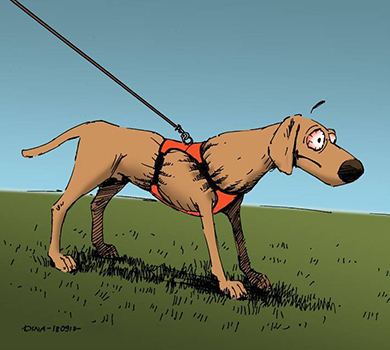Information misleading customers, disguised as expert opinion, is circulating on the Internet about certain dog harness types being unhealthy, while other harnesses are not.
The proliferators of fake news, without actually studying and having real knowledge of dog harnesses and their effects, and just based on the movement of the shoulders of the dog, drew the conclusion that straps running above the shoulder, touching the neck line, are “”healthy””, while those surrounding the chest are not. Naturally, the leading representatives of this opinion recommend specific dog harness brands and are careful to ensure that their professional expertise is supported by amateur videos and untraceable, seemingly scientific references.

The fact is, however, that there is no scientific test that would provide information on the long-term effects of dog harnesses. The only way to analyse the long-term wear of harnesses is to involve long-term users of a particular harness in studies. Julius-K9® IDC® Powerharnesses, manufactured for more than 20 years, are suitable for this purpose, as they retain their stability even after many years of use.
The people peddling news that can completely mislead dog owners even go as far as to allege that: Y-harnesses or pulling harnesses do not place an unhealthy load on the neck and spine of the dog at all. They avoid the subject of size selection and proper adjustment, which is of primary importance in the case of dog harnesses, irrespective of the type. They understate the fact that the introduction into the market of dog harnesses placing a load on the chest muscles was necessitated by the need to avoid a load on the neck, the microtrauma acting on the blood vessels and nerves in the neck. They wrongly conclude that the shoulders of the dog are restricted by every other type of dog harness, and that only the harness types preferred by them are “healthy”. To support this, they use manipulated figures presenting harnesses – with apparently poor size selection – on dogs or skeletons, and cite German university research, which, for example, that did not study the effects of dog harnesses, but rather the movement of dogs.
It is important to stress that the Julius-K9® brand conducts scientific research in order to determine which harness type places a load on or relieves which areas of the body when the dog is moving. In accordance with this, we aim to assist all dog owners with authentic information and constant development regarding all types of harnesses.
Gyula Julius Sebö